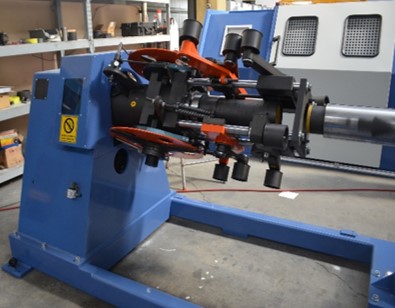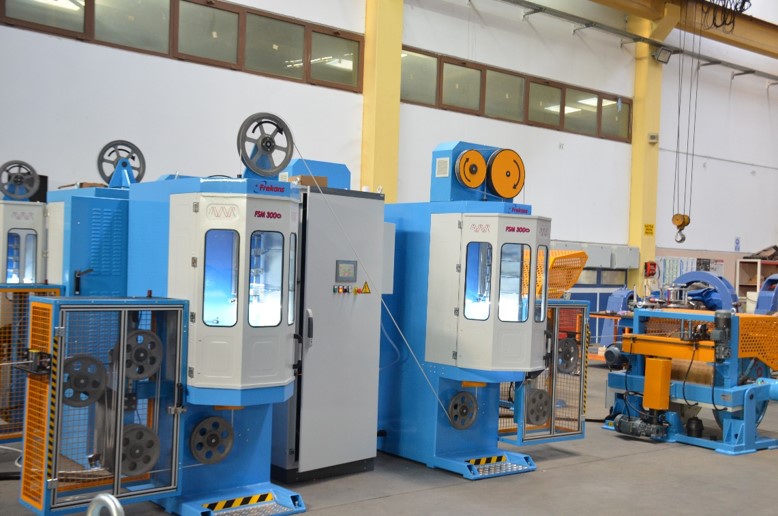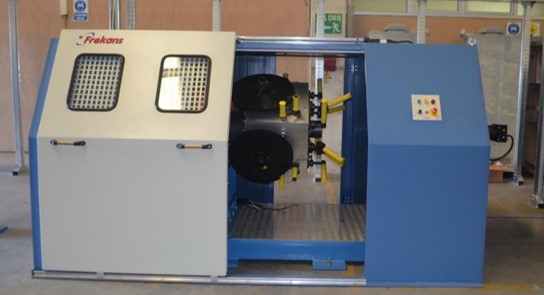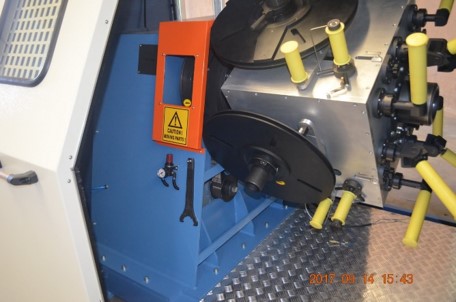What Is a Cable Taping Machine? – A Complete Guide to High-Speed, Spiral, and Vertical Configurations
In today’s advanced cable and wire manufacturing industry, precision and reliability are non-negotiable. One critical process that ensures consistent insulation, fire resistance, and mechanical strength is cable taping. At the center of this process stands the cable taping machine—an automated solution engineered to wrap various types of tape materials around cables and conductors with unmatched accuracy.
Whether you are producing high-frequency coaxial cables, fire-resistant power lines, or complex automotive wire harnesses, selecting the right cable taping machine directly impacts product quality, compliance with industry standards, and long-term performance. This guide explores the fundamental principles of cable taping machines, dives deep into different configurations such as high-speed, spiral wrap, and vertical models, and provides expert insight on how to choose the ideal solution for your specific application.
By the end of this article, you’ll gain a comprehensive understanding of how cable taping machines work, what differentiates each type, and how emerging technologies are shaping the future of cable insulation and protection.

steel taping machine
This article may interest you. The Latest Tech Trends in Cable Manufacturing Equipment
What Is a Cable Taping Machine?
A cable taping machine is a specialized piece of industrial equipment designed to wrap insulating or protective tape around wires, cables, and conductors in a precise and uniform manner. This process is essential in manufacturing electrical cables that meet strict performance, safety, and durability requirements across industries such as aerospace, automotive, telecommunications, and energy.
The core function of a cable taping machine is to rotate or feed the cable while simultaneously applying one or more layers of tape under controlled tension and angle. The machine ensures that each wrap is consistent, preventing air gaps, overlaps, or material stretching that could compromise electrical insulation or mechanical integrity.
A typical cable taping system includes:
- Pay-off unit: feeds the bare cable or conductor
- Taping head: applies the tape concentrically or eccentrically
- Tape spool holders: carry various tape materials (mica, PTFE, polyester, etc.)
- Take-up unit: rewinds the finished, taped cable
- Control system (PLC/HMI): allows precise settings for tape pitch, angle, speed, and tension
In both high-speed production lines and small-batch environments, cable taping machines play a crucial role in delivering consistent product quality, reducing human error, and improving manufacturing efficiency.
Key Types of Cable Taping Machines
Cable taping machines come in various types, each designed to meet specific production requirements, tape materials, and cable configurations. Understanding these types helps manufacturers choose the most efficient solution for their application.
Based on Taping Head Mechanism
- Eccentric Taping HeadEccentric (or offset) taping heads wrap tape in a spiral or helical pattern around the cable. This is ideal for flexible cables, wire harnesses, and applications where full coverage is achieved through overlapping layers. It allows adjustable pitch and is widely used in automotive and aerospace industries.
- Concentric Taping HeadConcentric heads apply tape evenly and directly around the cable’s circumference, often used for shielding or insulation layers that require uniform thickness. This method is common in high-frequency cables or where precise dielectric consistency is critical.
Based on Tape Material Compatibility
Cable taping machines can handle a wide range of insulating and protective tapes, including:
- Mica tape: Fire-resistant and heat-proof, used in safety-critical cables
- PTFE (Teflon): High dielectric strength, chemical and temperature resistance
- Polyester & Polyimide: Durable and lightweight for general insulation
- Glass fiber: Excellent thermal and mechanical stability
- Aluminum or Copper Foil: EMI shielding in communication cables
Choosing a machine compatible with the desired tape material is crucial for achieving reliable performance and bonding.
Based on Operation Mode
- Manual Taping MachinesSuitable for low-volume production or prototyping, these require more operator involvement but are cost-effective for small operations.
- Semi-Automatic Taping MachinesCombine some automation with manual adjustments; ideal for mid-scale production environments.
- Fully Automatic Taping MachinesThese systems include programmable PLCs, HMI touchscreens, and recipe memory functions. Operators can set speed, tape angle, tension, and layer count with minimal intervention—perfect for mass production and high precision.

kağıt bantlama makinası paper taping machine
High-Speed Cable Taping Machines
In large-scale cable manufacturing, high-speed cable taping machines are essential for maintaining production efficiency without compromising quality. These machines are engineered to deliver precision at high rotational or linear speeds, often exceeding 1000 RPM, making them ideal for high-throughput environments such as data cable, power line, and telecommunications production.
Key Advantages:
- Increased Productivity: High-speed taping reduces cycle time and increases output per shift.
- Consistent Quality: Advanced tension control systems ensure the tape is applied uniformly, even at high speeds, eliminating wrinkles or gaps.
- Minimal Downtime: Equipped with automatic tape break detection and quick-change reel systems, these machines allow rapid maintenance and minimal interruption.
- Digital Controls: Modern high-speed systems use PLC and HMI interfaces to adjust pitch, angle, and tape path with digital accuracy and repeatability.
Use Cases:
- Data and Communication Cables: Shielding layers of coaxial or fiber optic cables require fast, uniform taping.
- Energy Sector: Power transmission lines benefit from high-speed taping with fire-retardant or semi-conductive tapes.
- Industrial Automation: For factories producing thousands of meters of cable per day, high-speed taping machines are a critical part of a lean and scalable manufacturing system.
With the right configuration, high-speed taping machines can be seamlessly integrated into automated production lines, providing not only speed but also traceability, real-time monitoring, and recipe-based settings for product consistency.
Spiral Wrap Cable Taping Machines
Spiral wrap cable taping machines are designed to apply tape around cables in a helical or spiral pattern. This configuration is particularly useful for applications requiring flexibility, partial coverage, or layered protection. The spiral wrapping technique allows the tape to be applied at a controlled angle and pitch, ensuring tight and even insulation over the length of the cable.
How It Works:
The cable is fed through the center of a rotating taping head, while the tape is guided at an angle to create a continuous spiral wrap. The pitch (distance between each tape overlap) can be adjusted based on tape width, application needs, and cable diameter.
Advantages of Spiral Wrapping:
- Enhanced Flexibility: Spiral wrapping does not stiffen the cable, making it ideal for applications like automotive wiring or robotic arm cables where movement is frequent.
- Layer Control: Multiple layers of tape can be applied in alternating directions for better insulation or mechanical protection.
- Custom Coverage: Adjustable wrap angles allow partial or full coverage, depending on electrical or thermal protection requirements.
Common Applications:
- Wire Harnesses: Especially in automotive and aerospace industries, spiral wrapping is used to group and protect multiple wires while maintaining flexibility.
- Defense & Aerospace: Spiral wrap techniques are essential for managing electromagnetic interference (EMI) and mechanical durability.
- Industrial Machinery: Control cables and sensor wires benefit from spiral wrap for added abrasion resistance.
Spiral wrap cable taping machines are often equipped with programmable logic controls to set exact angles, tape tension, and rotation speed, allowing manufacturers to produce highly customized cable insulation profiles with minimal operator effort.

bantlama makinası fsm cable taping machine fsm
Vertical and Horizontal Taping Configurations
The configuration of a cable taping machine—whether vertical or horizontal—has a significant impact on space efficiency, operator accessibility, and production workflow. Choosing the right layout depends on the type of cable being processed, the available factory floor space, and the desired level of automation.
Vertical Taping Machines
Vertical configurations position the cable vertically, usually from top to bottom. This setup is preferred for:
- Long, heavy, or coiled cables
- Multi-layer taping applications
- Gravity-assisted feeding and alignment
Advantages:
- Better control over layer alignment in gravity-assisted wrapping
- Ideal for floor-mounted, high-tension operations
- Space-saving in compact production cells with high ceilings
Horizontal Taping Machines
Horizontal machines lay the cable parallel to the ground, which is the more traditional setup.
Use cases include:
- Lightweight or short-length cables
- Wire harnesses with complex branching
- Inline production with other horizontal equipment
Advantages:
- Easier operator access and maintenance
- Integration into existing horizontal processing lines
- Better suited for high-speed taping with modular design
Which One Should You Choose?
When selecting between vertical and horizontal configurations, consider:
- Cable type and length
- Required number of tape layers
- Floor plan and production flow
- Operator safety and ease of use
Modern cable taping systems often come with modular design options, allowing conversion between vertical and horizontal setups or hybrid layouts for flexible production needs.
Application Areas of Cable Taping Machines
Cable taping machines are used across a wide range of industries where electrical insulation, mechanical protection, or thermal resistance is critical. The versatility of these machines—especially in terms of tape type, wrapping angle, and layer count—makes them suitable for both specialized and high-volume cable production.
Automotive Industry
In modern vehicles, wire harnesses are extensive and complex. Cable taping machines ensure:
- Uniform wrapping of harness branches
- Improved resistance to vibration and abrasion
- Neat bundling for easier installation and diagnostics
Automated spiral taping is especially useful for flexible routing in engine compartments or moving parts.
Aerospace and Defense
These sectors demand extremely lightweight, EMI-shielded, and flame-retardant cabling. Cable taping machines enable:
- Application of Kapton, PTFE, and foil tapes
- Multi-layer concentric taping for shielding and insulation
- Compliance with stringent aerospace cable standards
Telecommunications
High-speed data transmission relies on consistent shielding and insulation. Taping machines provide:
- Precise wrapping for coaxial, fiber optic, and hybrid cables
- Stable dielectric properties via uniform layer application
- Custom pitch control for optimal signal integrity
Power and Energy
From underground cables to high-voltage lines, reliable taping is essential for:
- Heat resistance with mica or glass-fiber tapes
- Moisture and chemical barrier layers
- Fire-retardant insulation systems
Medical and Industrial Equipment
Specialty cables used in diagnostic tools, robotics, and control systems benefit from:
- Customized wrapping profiles
- Anti-microbial or chemical-resistant tape materials
- Miniaturized concentric taping for micro-cables
Whether for durability, flexibility, or regulatory compliance, cable taping machines play a pivotal role in producing cables that meet modern industrial demands.

kağıt bantlama makinası paper taping machine
Key Features to Look for When Choosing a Cable Taping Machine
Selecting the right cable taping machine requires careful consideration of your production goals, cable types, and technical expectations. The right features can dramatically improve efficiency, consistency, and long-term cost-effectiveness.
1. Advanced Tape Tension Control
Maintaining consistent tape tension is essential for avoiding wrinkles, gaps, or stretching during application. Machines with automatic tension adjustment ensure repeatable quality across long production runs, regardless of tape material or cable thickness.
2. Programmable Wrap Angle and Pitch
The ability to digitally configure helix angle, tape pitch, and overlap rate provides flexibility for different cable designs. This is especially important for complex wire harnesses or cables with multiple layers.
3. Multi-Layer Taping Capability
Some applications require dual-layer or even triple-layer taping with different materials (e.g., a fire-resistant layer and an EMI-shielding layer). Machines with multiple spool holders and synchronized heads are ideal for this purpose.
4. PLC and HMI Integration
Modern cable taping machines are equipped with PLC (Programmable Logic Controller) and HMI (Human-Machine Interface) systems. These allow:
- Quick recipe changes
- Monitoring production in real-time
- Storing presets for different cable types
- Reduced setup time and human error
5. Auto-Stop and Fault Detection Systems
Features like automatic tape break detection, end-of-roll alerts, and emergency stop systems enhance operational safety and reduce downtime.
6. Modular and Customizable Design
A good machine should be scalable and adaptable to evolving production needs. Look for:
- Interchangeable taping heads
- Optional vertical or horizontal configuration
- Compatibility with various pay-off and take-up modules
7. Compact Footprint and Ergonomics
Especially for smaller workshops or high-density production areas, a space-saving design with easy operator access is a major advantage.
By prioritizing these features, manufacturers can ensure that their taping solution not only meets current production needs but also adapts to future cable technologies and market demands.

kağıt bantlama makinası paper taping machine
Future Trends in Cable Taping Technology
As technology evolves, cable taping machines are undergoing rapid innovation to meet the increasing demands of automation, precision, and sustainability. Here are some of the most significant trends shaping the future of cable taping technology:
1. AI-Assisted Tape Alignment
Emerging systems are integrating artificial intelligence and computer vision to monitor tape alignment in real-time. These systems can automatically adjust tension, angle, and pitch to correct deviations instantly, resulting in:
- Improved yield
- Less scrap material
- Enhanced product uniformity
2. Smart Diagnostics and Predictive Maintenance
With the rise of Industry 4.0, cable taping machines are now equipped with sensors and IoT connectivity. This enables:
- Real-time performance tracking
- Predictive maintenance alerts
- Minimization of unplanned downtime
Operators can be notified about bearing wear, tape supply issues, or abnormal vibration levels before failure occurs.
3. Eco-Friendly Tape Handling
Sustainability is becoming a major concern in cable manufacturing. Newer taping machines are optimized for:
- Using biodegradable or recyclable tape materials
- Minimizing tape waste through precision control
- Supporting low-energy operation modes
This trend not only meets environmental standards but also helps companies lower operational costs.
4. Hybrid Taping Capabilities
Machines are increasingly designed to handle multiple types of tape in one setup, allowing transitions between PTFE, mica, polyester, or foil tapes without extensive downtime or tool change. This flexibility is key in serving diversified industries with a single platform.
5. Digital Twin Technology
High-end manufacturers are beginning to adopt digital twin models of taping systems. This allows engineers to simulate production runs, test recipes virtually, and optimize parameters before real-world deployment.
These innovations are turning cable taping from a basic mechanical process into a data-driven, intelligent manufacturing solution—capable of delivering higher efficiency, quality, and adaptability.
Why the Right Cable Taping Machine Matters
In an increasingly competitive manufacturing landscape, investing in the right cable taping machine is more than a technical decision—it’s a strategic advantage. Whether you’re producing high-speed data cables, fire-resistant power lines, or flexible wire harnesses, the taping process directly affects product durability, safety, and compliance.
As we’ve explored throughout this guide, there are numerous configurations, materials, and features available to meet specific needs. From high-speed concentric systems to spiral wrap machines with automated tension control, the ideal solution depends on your production scale, cable type, and desired quality standards.
By focusing on key factors such as tape compatibility, tension control, layer capacity, and smart diagnostics, manufacturers can significantly boost their operational efficiency and reduce long-term costs.
Choosing the right cable taping machine is not just about wrapping wires—it’s about wrapping precision, reliability, and innovation into every meter of cable you produce.



